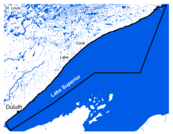Lower Shore: Duluth to Two Harbors
Some rough winds and rain slowed angling down on Lake Superior at times last week. Anglers reported surface water temps in the upper 50’s and low 60’s due to the abnormally warm weather. Lake trout fishing was still very good on the nice days running hot color spoons, flasher fly rigs, and meat rigs around 150 feet down in 200+ feet of water. The Knife River area seemed to produce the largest fish of all the areas anglers reported catching fish. Jigging was also very productive for nice Lakers in the Two Harbors area at 140-160 feet down. Stories of folks catching Salmon were very sparse this week with most of the fish further north and staging near streams.
Upper Shore: Twin Points to Hovland
Surface water temps were around 60 °F this week which is rather warm for this time of the year. Anglers reported this warm water extended deep into the water column. Taconite Harbor, Grand Marais, and Hovland anglers reported the Lake Trout were primarily suspended anywhere from 100-200 feet below the surface. Higher numbers of fish were showing up on their electronics but were not very reactive to lures and this did not translate into more catches. However, fair numbers of Siscowet were caught, along with a few nice lean Lake Trout. Most Lakers were in the 3-7 pound range with some as large as 15 pounds. Pink Salmon are in the rivers in fair numbers, but it may be short lived as the water is low and warm. Shore anglers struggled to catch fish with the warm surface temps keeping Lake Trout deep.
Management Updates
Anglers have seen an increase in the number of Sea Lamprey and Sea Lamprey wounds on fish caught in Lake Superior this year. The U.S. Fish & Wildlife Service and Fisheries and Oceans Canada are the two Federal agencies tasked with Sea Lamprey assessment and control under the auspices of the Great Lakes Fishery Commission. In 2020, thirty tributaries around Lake Superior were scheduled to be treated to kill larval Sea Lamprey before they become parasitic and feed on fish. However, only 10 of those tributaries were treated due to travel restrictions associated with the COVID-19 pandemic. Unfortunately, this increase in adult Sea Lamprey abundance, increased wounding on Lake Trout, and an increase in the number of fish killed (each Sea Lamprey consumes 40 pounds of fish in its lifetime) was anticipated but should be short-lived. Treatments on Lake Superior tributaries have since resumed and anglers should notice fewer Sea Lamprey and Sea Lamprey wounds on fish over the next few years.
For more information on Sea Lamprey control in the Great Lakes check out the Great Lakes Fishery Commission website and the most recent report Sea Lamprey Control in the Great Lakes 2023 from the U.S. Fish and Wildlife Service and Fisheries and Oceans Canada.
Helpful Links
 Questions?
Visit us online at mndnr.gov
If this message was shared with you, sign up to receive it at the link above.
Email us at Lake Superior fishing report
Give us a call at 218-302-3277
Fishing report hotline at 218-302-3293
Report suspicious activity at 800-652-9093
|